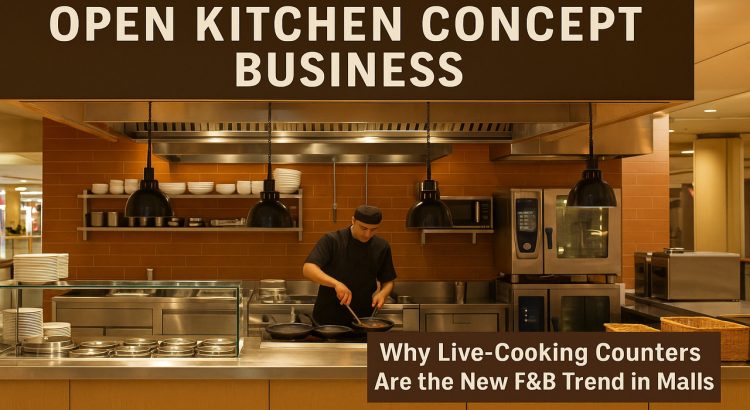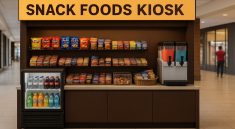The Berkshire Mall – The modern shopping mall is no longer just a destination for retail therapy. It’s evolving into a lifestyle hub where food plays an increasingly central role. As consumer expectations shift toward transparency, entertainment, and immersive experiences. One trend has emerged at the intersection of dining and spectacle the open kitchen concept particularly the live-cooking counter.
These culinary setups, where chefs prepare meals right in front of diners, have moved from upscale restaurants into the bustling corridors of shopping centers. And their presence is transforming how people engage with food, drawing crowds not only for the taste but also for the show.
The Appeal of Transparency and Trust
One of the biggest factors driving the rise of open kitchen counters in malls is the demand for transparency. In a post-pandemic world, hygiene and food safety have become top priorities for consumers. Seeing meals prepared in real time by gloved, skilled professionals builds confidence and eliminates the mystery surrounding kitchen practices.
Open kitchen concept counters allow customers to watch every step of the process from ingredient selection and preparation to cooking and plating. This visibility not only ensures accountability but also showcases the freshness and quality of ingredients. Particularly important in premium or health-conscious food brands.
For mall-based food entrepreneurs, the open kitchen becomes a silent sales pitch. Clean, well-organized counters and confident chefs at work create a sense of professionalism and reliability, reassuring passersby and prompting impulse purchases.
“Read More: Make Thai Tea Like a Pro with This Easy Home Recipe”
Creating Entertainment and Engagement
Malls are under pressure to remain relevant in an age of online shopping. One strategy that works: turning visits into experiences. Open kitchen counters fit perfectly into this strategy by blending food with entertainment.
Whether it’s a sizzling teppanyaki grill, a pasta tossed in a flaming parmesan wheel, or fresh dumplings folded by hand, live cooking captivates. Customers stop, watch, film for social media, and most importantly buy. The theatrical nature of cooking becomes part of the product itself.
This concept borrows from the principles of “eatertainment” a fusion of eating and entertainment. By inviting customers to watch their food come to life, brands forge emotional connections and create memorable moments that go beyond flavor.
Space Efficiency Meets Visual Impact
In the often limited footprint of mall kiosks or food stalls, open kitchens maximize space while enhancing visibility. Instead of hiding operations behind walls, the entire cooking station becomes the front-of-house. This reduces construction costs and eliminates the need for large back-end kitchens.
Visually, an open kitchen acts as an organic form of signage. Bright flames, bubbling sauces, or freshly baked items immediately catch the eye and differentiate the vendor from nearby competitors. Combined with strategic lighting, modern equipment, and minimalist counter designs, open kitchens exude professionalism in a compact format.
Many malls are now designing dedicated food areas or “culinary clusters” that embrace this setup, encouraging vendors who can offer both quality and spectacle.
“Read More: Shopping Mall Kiosk Businesses: Creative Concepts That Turn Footfall into Profit”
Building Brand Identity Through Chef Interaction
In traditional quick-service restaurants (QSRs), the cook remains anonymous behind closed doors. But with live-cooking counters, the chef becomes a brand ambassador. This opens the door for storytelling, interaction, and personalization essential ingredients for customer loyalty in today’s competitive F&B market.
Some businesses have taken this a step further by branding their chefs, encouraging staff to engage with diners, explain ingredients, or customize dishes in real time. This interaction fosters trust and builds repeat business.
The chef’s face, demeanor, and confidence contribute to the overall perception of the brand. A smiling chef serving sizzling satay skewers or crafting personalized ramen bowls becomes a walking, talking, cooking representative of what the business stands for: freshness, quality, and care.
Live Kitchens for Every Cuisine
One of the strengths of the live-cooking concept is its versatility across culinary genres. Asian cuisines such as sushi, Korean BBQ, and Thai street food are naturally suited to visual preparation. But the trend isn’t limited to one region.
Pizza ovens, crêpe stations, burger grills, taco bars, and even smoothie counters are being reimagined with open kitchen formats. The key is to identify which part of the cooking process is visually engaging and capitalize on it.
Dessert brands, for instance, have found success with made-to-order waffles, molten chocolate fountains, and rolled ice cream stations delighting customers with both indulgence and entertainment.
Integration with Social Media and Digital Marketing
In today’s F&B environment, virality can be as valuable as flavor. Live-cooking counters provide endless content opportunities. Patrons love recording food being prepared and posting it online, essentially offering free marketing to thousands of followers.
Many brands now encourage this by designing visually “Instagrammable” setups, complete with neon signs, branded plating, and open angles for filming. Some even incorporate screens showing live cooking action or displaying customer reactions. Creating a digital loop of engagement that extends far beyond the food court.
Moreover, digital orders can be integrated with live preparation allowing customers to watch their online order being made on-site through screens or apps. This blend of digital and physical experience is redefining convenience and immersion in food retail.
Opportunities for Workshops and Food Education
Some innovative mall-based F&B businesses are using Open Kitchen Concept not only for serving meals but also for hosting workshops, live demos, or tastings during off-peak hours. These events serve multiple purposes: they build community engagement, educate the public about the cuisine, and create buzz around the brand.
Imagine a sushi stall offering short rolling classes on weekend afternoons, or a fresh pasta kiosk hosting chef-led tastings of different sauces. These experiences enhance customer loyalty and distinguish a brand in a sea of fast-service options.



